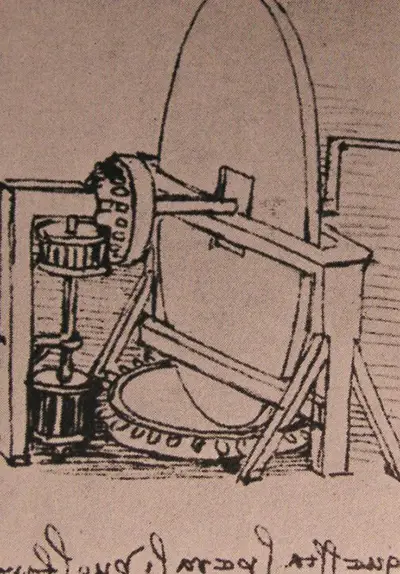It is created using pen and ink on paper and has all of the hallmarks of Leonardo's engineering based sketches: strong lines and neat explanatory annotations to the side of them in da Vinci's characteristic mirror writing.
As we can see from the drawing entitled Design for a Machine for Grinding Convex Lenses, da Vinci envisioned using a selection of interlocking cogs and a central heavy wheel to grind delicate glass lenses with the utmost precision.
It resembles other grinding machines such as flour mills. The drawing is dated to around 1500, placing it well within the period known as the High Renaissance.
At the time when da Vinci created this piece (which can be seen as a functional sketch or as a work of art), all kinds of lenses were very popular.
This was a time of great astronomical exploration, and lenses were being used to fit in to telescopes, to magnify objects and also to wear as spectacles.
Hand grinding lenses could be time consuming and difficult (and expensive if you paid somebody else to do it: hence, centuries later the astronomers William and Catherine Herschel would create a lens grinding kit to create their telescope lenses by themselves at home).
As a result, there was a huge demand for equipment that could be used to grind lenses accurately and effortlessly, and within a tight time frame.
Convex lenses make light rays converge. This means that when you look through these lenses, far away objects look much closer to you. These are the types of lenses that are used in telescopes and binoculars. Thus, it is likely that Design for a Machine for Grinding Convex Lenses is designed for use to make telescope lenses.
Da Vinci made have intended to create such a machine for himself for personal use, or he may have meant to market it to telescope manufacturers.
It is definitely worthwhile comparing Design for a Machine for Grinding Convex Lenses to other scientific sketches by Leonardo da Vinci. His repertoire of scientific expertise and investigation spread from optics to biology, and from geology to civil engineering. He also sketched plans for hydraulic pumps, flying machines, and weapons of war, for example.
Like Design for a Machine for Grinding Convex Lenses, these scientific drawings show da Vinci's dynamic mind and his interest in creating a sense of movement with his sketches. Though Design for a Machine for Grinding Convex Lenses is a static ink on paper drawing, it seems to pop from the page and viewers get an instant sense of what it would look like if all of those cogs and wheels were in motion.


